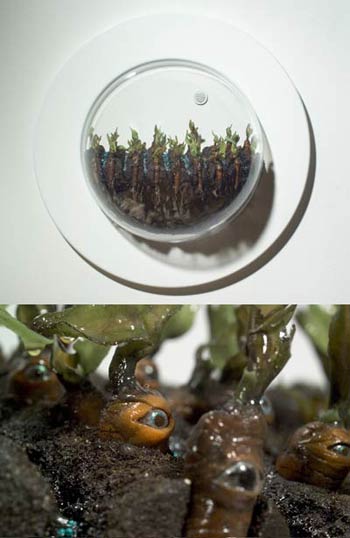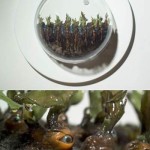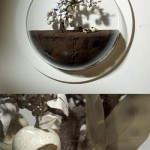By BEN SLOAT
The famed Russian born novelist (and noted lepidopterist) Vladimir Nabokov once wrote to his mother of the creative process: “We are translators of God's creation, his little plagiarists and imitators, we dress up what he wrote, as a charmed commentator sometimes gives an extra grace to a line of genius.” Nabokov understood his artistic methods as being the captured translation of surrounding creative miracles, of which he was witness. It's no wonder that his twin passions were writing and butterfly hunting; the first an act of creation, the second, its capture.
Having created in his earlier work an entire genus of different organisms evolved within the perils of the modern world (including birds, office plants, and yes, butterflies), Brian Burkhardt turns his attention to the formation of environments in New Crop, his solo exhibition currently on view at the Judi Rotenberg Gallery. Constructed of various natural and artificial materials, the majority of the pieces in this show are small worlds encased in glass domes, revealing the adaptation of plants and animals to environmental calamities or human intervention. There's an Arctic plum surviving off oil spill runoff, the bonsai tree which sprouts fruit in the shape of the Apple Inc. logo, or a new species derived from the mating of a starfish and a cactus.
Unique narratives with regards to the commodification and consumption of once organic elements are introduced as well. Strawberries, now adopting a square form, are first seen in one piece “Squareberry Crop Circle (Fragaria Adaptus Cuadrado/ Sqaureberries)” growing in circular formations of dirt. They reappear in another piece “New Crop” perfectly packaged in plastic containers and covered in white chocolate under a cake dome. This creepy blend of human ingenuity imposed upon nature's innovations parallels current advances in biotechnology, and speaks further towards the nature of our species to control, make efficient, and dominate the natural world, even at our own expense. With the current development of square watermelons in Japan as a means to solve the problem of product space and transport, square strawberries don't seem so far away from the grocer's aisle.
Though an environmental stance is alluded to, the work is far from didactic. Burkhardt, like his Artic plum responding to devastation, develops new behavioral characteristics as a means of coping and utilizes creativity as the ultimate method for survival. The viewer is invited as a witness to these expertly made imaginations that are fun but not frivolous, remarking on tragedy yet filled with wonder.
The use of the glass domes in New Crop parallels the same dressed up God's eye view described by Nabokov, one can see not only the fantastically detailed creatures and environment in which they exist, but also the subterranean elements, often containing numerous subtle qualities and new mysterious creatures.
If anything, the most notable characteristic of this exhibition, as with much of Burkhardt's work, is the blend of a sharp wit with his obsessively and intricately formed fabrications - reflecting the artist's own compulsive desire to evolve, to adapt, to create.
- Brian Burkhardt, Beta X Press, (installation view & detail) Mixed media, 2007.
- Brian Burkhardt, iMacintosh Bonsai, (installation view & detail) Mixed media, 2007.
----
"Brian Burkhardt: New Crop" is on view May 3- June 2, 2007 at Judi Rotenberg Gallery.
All images are courtesy of the artist and Judi Rotenberg Gallery.






